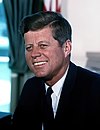
Intelsat S.A. is a multinational satellite services provider with corporate headquarters in Luxembourg and administrative headquarters in Tysons Corner, Virginia, United States. Originally formed as International Telecommunications Satellite Organization, from 1964 to 2001, it was an intergovernmental consortium owning and managing a constellation of communications satellites providing international telecommunications and broadcast services.

A communications satellite is an artificial satellite that relays and amplifies radio telecommunication signals via a transponder; it creates a communication channel between a source transmitter and a receiver at different locations on Earth. Communications satellites are used for television, telephone, radio, internet, and military applications. Many communications satellites are in geostationary orbit 22,300 miles (35,900 km) above the equator, so that the satellite appears stationary at the same point in the sky; therefore the satellite dish antennas of ground stations can be aimed permanently at that spot and do not have to move to track the satellite. Others form satellite constellations in low Earth orbit, where antennas on the ground have to follow the position of the satellites and switch between satellites frequently.

The Federal Communications Commission (FCC) is an independent agency of the United States government that regulates communications by radio, television, wire, satellite, and cable across the United States. The FCC maintains jurisdiction over the areas of broadband access, fair competition, radio frequency use, media responsibility, public safety, and homeland security.

The Communications Act of 1934 is a United States federal law signed by President Franklin D. Roosevelt on June 19, 1934, and codified as Chapter 5 of Title 47 of the United States Code, 47 U.S.C. § 151 et seq. The act replaced the Federal Radio Commission with the Federal Communications Commission (FCC). It also transferred regulation of interstate telephone services from the Interstate Commerce Commission to the FCC.
Syncom started as a 1961 NASA program for active geosynchronous communication satellites, all of which were developed and manufactured by the Space and Communications division of Hughes Aircraft Company. Syncom 2, launched in 1963, was the world's first geosynchronous communications satellite. Syncom 3, launched in 1964, was the world's first geostationary satellite.

The Telecommunications Act of 1996 is a United States federal law enacted by the 104th United States Congress on January 3, 1996, and signed into law on February 8, 1996 by President Bill Clinton. It primarily amended Chapter 5 of Title 47 of the United States Code. The act was the first significant overhaul of United States telecommunications law in more than sixty years, amending the Communications Act of 1934, and represented a major change in that law, because it was the first time that the Internet was added to American regulation of broadcasting and telephony.

Low-power broadcasting is broadcasting by a broadcast station at a low transmitter power output to a smaller service area than "full power" stations within the same region. It is often distinguished from "micropower broadcasting" and broadcast translators. LPAM, LPFM and LPTV are in various levels of use across the world, varying widely based on the laws and their enforcement.
The fairness doctrine of the United States Federal Communications Commission (FCC), introduced in 1949, was a policy that required the holders of broadcast licenses both to present controversial issues of public importance and to do so in a manner that fairly reflected differing viewpoints. In 1987, the FCC abolished the fairness doctrine, prompting some to urge its reintroduction through either Commission policy or congressional legislation. The FCC removed the rule that implemented the policy from the Federal Register in August 2011.
PanAmSat Corporation was a satellite service provider headquartered in Greenwich, Connecticut, United States. Founded in 1984 by Reynold "Rene" Anselmo, it operated a fleet of communications satellites used by the entertainment industry, news agencies, internet service providers, government agencies, and telecommunication companies. Anselmo got the idea for PanAmSat from Norm Leventhal, a communications lawyer in Washington, D.C., to whom he had turned to for advice regarding difficulties he was encountering in getting reasonably priced satellite transmission for his Spanish International Network (SIN), the current-day Univision. Anselmo financed the entire project himself and Leventhal's law firm, hiring Martin Rothblatt for special satellite technical advice, filed for approval from the Federal Communications Commission (FCC) and lining up an initial satellite from RCA Astro-Electronics and a heavily discounted launch from Arianespace.

The Cable Communications Policy Act of 1984 was an act of Congress passed on October 30, 1984 to promote competition and deregulate the cable television industry. The act established a national policy for the regulation of cable television communications by federal, state, and local authorities. Conservative Senator Barry Goldwater of Arizona wrote and supported the act, which amended the Communications Act of 1934 with the insertion of "Title VI—Cable Communications". After more than three years of debate, six provisions were enacted to represent the intricate compromise between cable operators and municipalities.
COMSAT is a global telecommunications company based in the United States.

Commercial use of space is the provision of goods or services of commercial value by using equipment sent into Earth orbit or outer space.
The British space programme is the British government's work to develop British space capabilities. The objectives of the current civil programme are to "win sustainable economic growth, secure new scientific knowledge and provide benefits to all citizens."

The Internet in the United States grew out of the ARPANET, a network sponsored by the Advanced Research Projects Agency of the U.S. Department of Defense during the 1960s. The Internet in the United States in turn provided the foundation for the worldwide Internet of today.
After President Nixon took office in 1969, Clay T. Whitehead, Special Assistant to the President, pushed to establish an executive office dedicated to telecommunications policy. The White House Office of Telecommunications Policy (OTP) was established in 1970. In 1978, it was merged, along with the Commerce Department's Office of Telecommunications, into the newly created National Telecommunications and Information Administration (NTIA).

The Cable Television Consumer Protection and Competition Act of 1992 is a United States federal law which required cable television systems to carry most local broadcast television channels and prohibited cable operators from charging local broadcasters to carry their signal.

Telstar is the name of various communications satellites. The first two Telstar satellites were experimental and nearly identical. Telstar 1 launched on top of a Thor-Delta rocket on July 10, 1962. It successfully relayed through space the first television pictures, telephone calls, and telegraph images, and provided the first live transatlantic television feed. Telstar 2 was launched May 7, 1963. Telstar 1 and 2—though no longer functional—still orbit the Earth.

The Federal Communications Commission Consolidated Reporting Act of 2013 is a bill that passed the United States House of Representatives during the 113th United States Congress. The bill would "require the Federal Communications Commission (FCC) to prepare a biennial report for the Congress that assesses certain characteristics of the communications industry." That report would include an analysis of "the state of competition in the markets for voice, video, and data services, as well as the availability of high-speed and high-quality telecommunications services" in the United States. Perhaps most importantly, "the bill would require the FCC to determine whether laws and regulations pose a barrier to entry into communications markets and to include that information in the biennial report." The bill would also cancel a number of preexisting requirements for various other reports from the FCC.

The C band is a designation by the Institute of Electrical and Electronics Engineers (IEEE) for a portion of the electromagnetic spectrum in the microwave range of frequencies ranging from 4.0 to 8.0 gigahertz (GHz). However, the U.S. Federal Communications Commission C band proceeding and auction, designated 3.7–4.2 GHz as C band. The C band is used for many satellite communications transmissions, some Wi-Fi devices, some cordless telephones, as well as some radar and weather radar systems.
Intelsat IV F-6 was a geostationary communication satellite built by Hughes, it was owned by Intelsat. The satellite was based on the HS-312 platform and its estimated useful life was 7 years.












